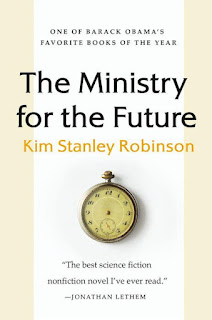Imagine if death on that scale happened in the real world. How would we react? Would we finally change? That's where we start in this novel about what it'll take to stop climate change and, essentially, continue living on this planet.
Our main character, as much as there is one, is a woman named Mary who has been tapped to lead the newly developed Ministry for the Future, headquartered in Zurich, Switzerland. It's 20-30 years in the future (from our present day) and this organization has been created by the signees of the Paris Climate Agreement to literally save the world. One of the very few people who survived the Indian heat wave, an American named Frank who had been there working for a relief organization, then seeks out Mary and to tell her his story and advocate for fast and far-reaching change. The two form an unlikely bond.
But this plot is almost secondary to Robinson taking us through a litany of vignettes all over the world describing how people are experiencing the climate crisis (climate refugees, animal extinction, a flood in Los Angeles, and so many more). These set pieces show us the magnitude of the problem and how difficult the Ministry for the Future's task is. But through a combination of changes to the global banking system, some creative geoengineering, reforestation and re-wilding natural habitats, and even some rather nefarious tactics it'd be easy to label as eco-terrorism, change begins to happen.
Robinson spares no detail in the explanations of these solutions, and it's mostly pretty interesting. But there are times it's a little dry, frankly — Robinson takes us deep into the weeds of global finance and economic theory. Also, there are (to me) pretty interminable descriptions of hiking expeditions in the Alps. And some of the little sections, like two told from the points of view of a photon and History, just feel a little off.
But overall, it's a sobering, but illuminating and hopeful, view of what will need to happen to ensure we actually do have a future. In the real world, will we have the resolve to make these changes before it's too late?


No comments:
Post a Comment